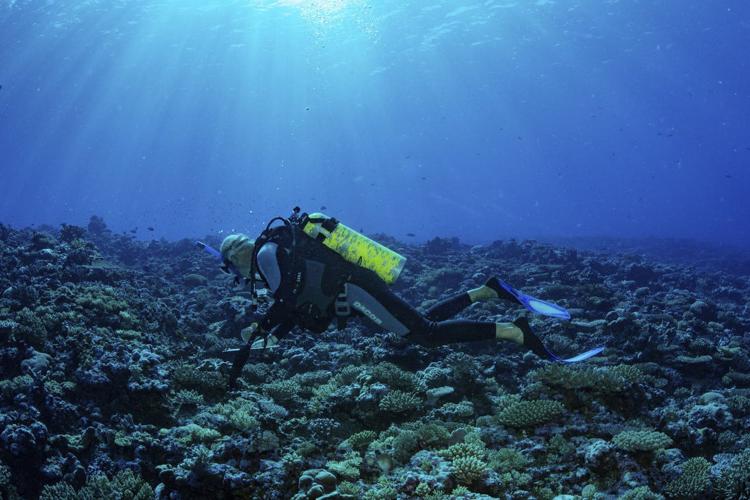What is the Coral Species Identification Training Program?
The NOAA Fisheries Pacific Islands Regional Office (PIRO) developed the Coral Species Identification Training Program to increase capacity of coral reef monitoring efforts in the U.S. Pacific Islands and various other Pacific Island nations. The program provides free training and resources for identifying Indo-Pacific reef-building corals including 15 species that are listed as threatened under the Endangered Species Act. This includes the listed and unlisted corals found in each archipelago covered by the program.
Meet the trainers
The Coral Identification Training Program is led by PIRO contractor, Dr. Douglas Fenner, and supported by PIRO staff, Lance Smith. Training is tailored for the audiences in the various archipelagos since the coral community in each location is unique. Dr. Fenner has written coral species identification guidebooks for the ESA-listed corals as well as other reef-building corals in each U.S. Pacific Islands jurisdiction area (American Samoa, the Commonwealth of the Northern Mariana Islands, Guam, Hawaiʻi, and the Pacific Remote Island Area) and several neighboring or nearby foreign countries.
Is the training in person or online?
Training can be provided in person or online, subject to requested dates and availability of resources.
How much does the training cost?
The coral species identification training is free.
How do I request training?
You can request training by emailing Douglas Fenner or Lance Smith.
Where can I find Coral Species Identification Guidebooks?
You can view and download the free guidebooks below:
- Field Guide to the Threatened Corals of the U.S. Pacific Islands
- Field Guide to the Corals of the Federated States of Micronesia
- Field Guide to the Corals of Palau
- Field Guide to the Corals of the Samoan Archipelago
- Field Guide to the Corals of Tonga
- Field Guide to the Corals of Wake Island
- Field Guide to the Corals of Nauru
Other guidebooks are available upon request by emailing Douglas Fenner or Lance Smith:
- Corals of Hawaiʻi (2nd edition, 2023)
- Field Guide to the Corals of Fiji (in revision)
- Field Guide to the Corals of Vanuatu (expected to be published by C2O Coasts Climate Oceans in late 2023)
- Field Guide to the Corals of the Marshall Islands (published in 2022 by the Marshall Islands Marine Resources Authority)
- Field Guide to the Corals of Wallis Island (Wallis & Futuna)
- Field Guide to the Corals of the Northern Mariana Islands
What does the training involve?
This training is designed to make learning local coral genera and species as easy and rapid as possible. Coral species in the Indo-Pacific are diverse and difficult to identify. The training makes identification easier by dividing the process into small steps. First, participants learn how to recognize different coral colony shapes. Next, they learn what characteristics are common in the different coral genera. Finally, participants learn how to identify individual species based on their unique collection of physical attributes.
A single coral species may look slightly different depending on its location. All photos in the field guides and practice modules are of corals that are found in the specific location on which the training is focused. This greatly reduces the amount of work to learn them.
Does it cover all species in the guidebooks?
Yes, the full training includes all of the species in the local guide, which we produce and provide for free. However, each location is likely to have additional rare species that the author has not been able to find and photograph yet. Typical numbers of species in guides are usually over 100, with some around 200 or more.
Who is the coral identification training for and who can take it?
The training is intended for coral reef scientists, managers, monitoring teams, surveyors, and anyone interested in the identification of corals. There are no requirements for any previous knowledge.
How long is the training?
The training varies in length based on participant needs and the following training modules:
- I. Coral Colony Shapes–30 minutes
- II. Coral Genera Identification–half to full day, based on the number of coral genera photographed at your location
- III. Coral Species Identification–2 to 3 full days, based on the number of species photographed at your location
- IV. Coral Disease Guides–Coming soon!
Is coral taxonomy in flux?
Yes, very much so. The traditional taxonomy of reef-building coral species is based on physical characteristics, such as skeleton shape. This is the case for the hundreds of species in Corals of the World, which includes the ESA-listed corals. Our training and guidebooks follow this system, as does the information on our ESA-listed corals webpage.
There is discussion on revisiting coral taxonomy, as described by Project Phoenix. As taxonomic revisions are published in peer-reviewed scientific literature, we will update our training, guidebooks, and information accordingly.





